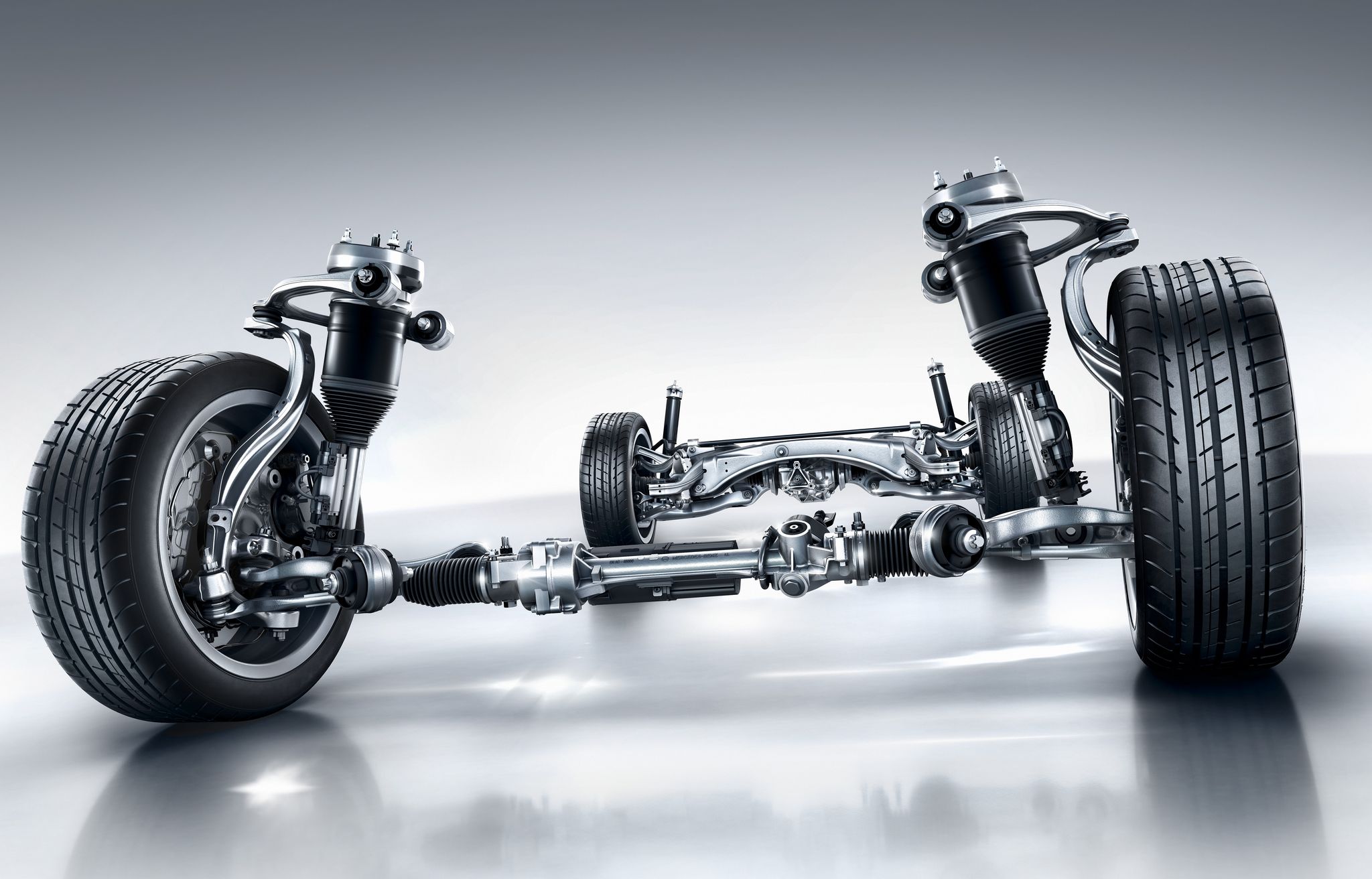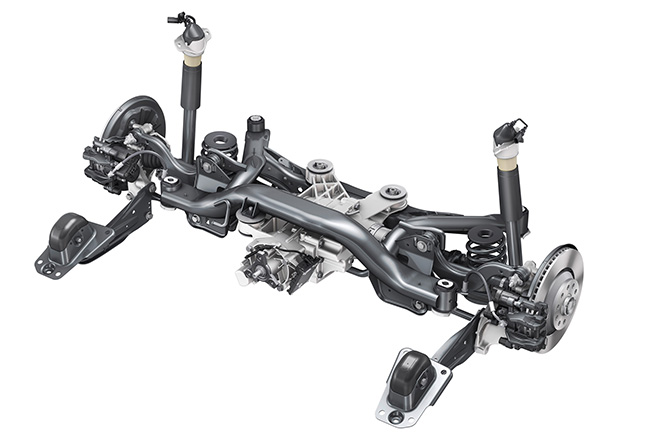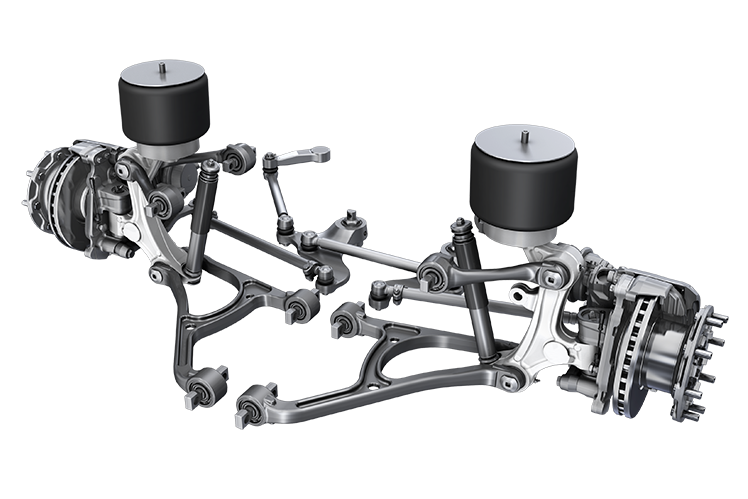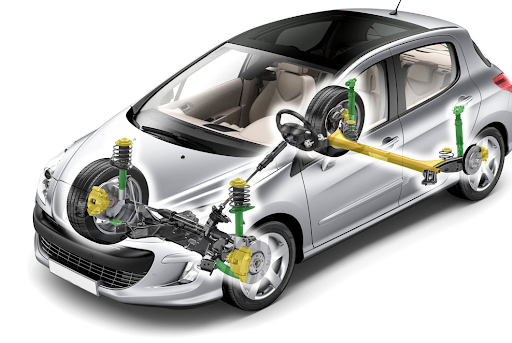If you’re thinking that the comfortable ride we enjoy today is largely attributed to modern advances in car suspension systems, then you’re absolutely right. But if you’re thinking that your car shocks have a very simple job, you may want to hold that thought since your car’s shock absorbers, or the suspension system in general, have several important roles to play in the optimum performance of your vehicle. Don’t worry, we’ll enlighten you on anything and everything about car suspension systems in this guide.
The Function Of A Suspension System
It is quite easy to get an idea of what a car’s suspension system does. From the term ‘suspension’ itself, it is already understood that you are essentially raising something from the ground – to suspend – in an effort to minimize the impact or effects of forces of the ground on this particular something. For instance, if you lay on your back on the ground, you will definitely feel almost every other vibration from other people walking by. Now try lying on a hammock suspended several feet off the ground and these vibrations disappear. You will surely be swayed by the wind but this is different from ground vibrations. This is, of course, an oversimplification of what car suspension system is. So we’ve outlined a few of the most important functions of modern car shocks and suspension.
 Absorbs Vibration, Gravitation, And Impact Forces From The Road
Absorbs Vibration, Gravitation, And Impact Forces From The Road
We can readily say that the suspension systems of the past were not really that efficient when it comes to absorbing all the different forces emanating from the road’s surface. While people way back then already started using padded cushions to lessen the impact of these forces on their butts, the ride was still far from comfortable. Such systems, thankfully, are a thing of the past. And while there may still be some car models that have suspension systems that are designed like those from the past, many of them provide greater shock and vibration absorption. So while it is not really a perfectly smooth bump-less ride, it is not bumpy either.
How Does the Suspension on a Car Work?
To put it simply, a car’s suspension is what separates us behind from the road while also preventing our vehicles from shaking and disintegrating themselves into smithereens. The point is quite simple. Even when you have the best-engineered road in the world, if you hurl a 2-ton metal at 80 mph you’re bound to get into serious trouble; you or your vehicle. So how do car suspensions really work?  If you look at every car that rolls out of the assembly line, almost every single one comes with independent suspension. This means each of the wheels or the axles is independently suspended so that when one wheel loses contact with the ground, the other 3 wheels are still in communication with the surface. If you’ve owned a toy car when you were still a child, you’d know this. Since the wheels on these toy cars were not ‘individually’ suspended, when you raise one corner of your toy car, the wheel on the same side of the elevated corner is also raised. Now, if there is an independent suspension, then the wheel on this side of the toy car will remain in contact with the surface.
If you look at every car that rolls out of the assembly line, almost every single one comes with independent suspension. This means each of the wheels or the axles is independently suspended so that when one wheel loses contact with the ground, the other 3 wheels are still in communication with the surface. If you’ve owned a toy car when you were still a child, you’d know this. Since the wheels on these toy cars were not ‘individually’ suspended, when you raise one corner of your toy car, the wheel on the same side of the elevated corner is also raised. Now, if there is an independent suspension, then the wheel on this side of the toy car will remain in contact with the surface.
Car-Dependent Suspension
This design of suspension system is very simple and as such is preferred by automotive manufacturers and even by DIY enthusiasts who would like to minimize cost while still delivering the basic functions of the mechanism. You can still see this type of setup in modern cars, especially in off-road vehicles. But honestly, how many among your office-going friends do you know will gladly take an off-roader to the office on a daily basis? Anyway, most of the vehicles that still employ the beam axle design have two different axles: live and dead. The live axles come with powered wheels while free-spinning tires are mounted onto dead axles. Unfortunately, there’s a major issue with such a design. Since the tires will be moving dependent on each other, their focus will be on the maintenance of the same angle relative to each other and not relative to the ground surface. What this simply means is that handling becomes less predictable as you’ve got less traction in your tires. Just think of that old toy car of yours.  There is another issue inherent to independent or beam axle systems. This design can greatly contribute to an increase in unsprung weight or weight that simply is not supported by the suspension parts of your car. Technically, this includes the mass of the wheel axles, tires, wheel hubs, and other components that are not supported by the car’s suspension. High unsprung weight can amplify vibrations or bumps felt on the road since these forces that are supposed to be absorbed by the tires are generally transmitted into the beam suspension parts. This, in turn, creates movement in the parts since there is a significantly greater mass in beam axles than in independent suspension systems. Additionally, high unsprung weight can also lead to issues of wheel control especially during hard acceleration or even braking. However, if the differential is attached to the vehicle’s body or frame instead of directly on the axle, then unsprung weight can be reduced. Still, it is no match against independent suspension systems when talking about riding comfort.
There is another issue inherent to independent or beam axle systems. This design can greatly contribute to an increase in unsprung weight or weight that simply is not supported by the suspension parts of your car. Technically, this includes the mass of the wheel axles, tires, wheel hubs, and other components that are not supported by the car’s suspension. High unsprung weight can amplify vibrations or bumps felt on the road since these forces that are supposed to be absorbed by the tires are generally transmitted into the beam suspension parts. This, in turn, creates movement in the parts since there is a significantly greater mass in beam axles than in independent suspension systems. Additionally, high unsprung weight can also lead to issues of wheel control especially during hard acceleration or even braking. However, if the differential is attached to the vehicle’s body or frame instead of directly on the axle, then unsprung weight can be reduced. Still, it is no match against independent suspension systems when talking about riding comfort.
Car Independent Suspension
As we have already mentioned above, independent suspension systems are the preferred set up by many of today’s manufacturers. Such a setup allows each wheel to travel independently of each other, up and down with the shock absorber and spring that are bolted to one end of a metal frame. On the other end of this frame is a control arm that connects the suspension to the chassis. Other systems come with a wishbone instead of a control arm which technically attaches the suspension frame at two points. The correct positioning of each car suspension part in a front-wheel independent suspension system is crucial to maintaining full control of the wheels while ensuring consistent wheel alignment. This helps ensure a much safer operation of your vehicle. Independent suspension systems designed for the rear wheels are essentially the same as those found in the front wheels, except that these don’t have to take into consideration steering dynamics. Most all-wheel-drive and rear-wheel-drive vehicles will have their differentials mounted to the suspension frame right in the middle of the wishbones or the control arms. On the other hand, front-wheel-drive vehicles don’t require such a complicated arrangement of parts. A simple set of shock absorbers and springs is often sufficient.
Independent suspension systems designed for the rear wheels are essentially the same as those found in the front wheels, except that these don’t have to take into consideration steering dynamics. Most all-wheel-drive and rear-wheel-drive vehicles will have their differentials mounted to the suspension frame right in the middle of the wishbones or the control arms. On the other hand, front-wheel-drive vehicles don’t require such a complicated arrangement of parts. A simple set of shock absorbers and springs is often sufficient.














[…] cleaner, make sure to have at least a face mask on since the mist can be inhaled through the lungs. It’s better to be […]
[…] Suspension […]
[…] Suspension […]
[…] Suspension […]
[…] Picanto 2019 This mini-car has been rated having a modest average of 22 km/L fuel efficiency, which makes it one of the most fuel-efficient vehicles currently marketed in our country. Still […]
[…] there are extra options available. It can be really hard to determine which ones are must-haves vs. nice-to-haves. In our opinion, there are three features that should be at the top of the […]
[…] weeks or months after the first warning signs emerge, or considering properly functioning brakes anything less than a top priority. From a safety standpoint, they are more important than the engine. After […]
[…] about viscosity grades, and our lack of understanding of the basic differences between mineral, synthetic and semi-synthetic […]
[…] the tyres that are mounted onto the wheels. Technically, your tyres are what connect your car to the ground. Such is the importance of tyres that we’ve prepared this ultimate guide to help you better […]
[…] and replacement of suspension, brakes, and […]
[…] and replacement of suspension, brakes, and […]
[…] where your vehicle is exposed frequently to the sun, your truck will need a paint coating. However, cars in places that don’t get a lot of suns don’t have to be coated. This is because […]
[…] fuel efficiency and one dangerous method – the first is coasting and the other is slip-streaming. Let’s take a look at coasting […]
[…] the brake line pressure independent of the pedal force to bring the wheel speed back to the slip level range that necessary to the optimal braking performance. The ABS does not allow a full wheel lock […]
[…] you will see the temperature range of the grease stated on the container that it is supplied in. Beyond this stated range, the grease loses structure and breaks down. It no longer supplies […]
[…] Picanto 2021 This mini-car has been rated having a modest average of 22 km/L fuel efficiency, which makes it one of the most fuel-efficient vehicles currently marketed in our country. Still […]
[…] 27, 2021 Posted by: Imran Khan No Comments There are three basic types of suspension components: linkages, springs, and shock absorbers. The linkages are the bars and brackets […]
[…] Suspension […]
[…] you buy a good quality car then keep in mind to invest your hard money on it because otherwise, you can buy a car but not a good quality car Pakistan is also […]
[…] back home from your work, as soon as you get in your car, your first step is to get rid of the hot air inside the car. So before getting inside open the […]
[…] weather places heavy demands on the battery and charging system. Recharge or replace weak batteries. Check fluid levels, battery posts, and charging […]
[…] the amount of air that can be pulled into the carburetor venture. The main issue with obtaining the best performance using a carburetor is that it can’t monitor the air to fuel ratio for each […]